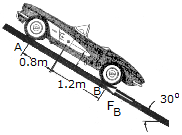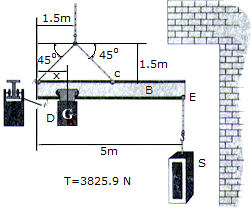Engineering Mechanics - Equilibrium of a Rigid Body
Why should I learn to solve Engineering Mechanics questions and answers section on "Equilibrium of a Rigid Body"?
Learn and practise solving Engineering Mechanics questions and answers section on "Equilibrium of a Rigid Body" to enhance your skills so that you can clear interviews, competitive examinations, and various entrance tests (CAT, GATE, GRE, MAT, bank exams, railway exams, etc.) with full confidence.
Where can I get the Engineering Mechanics questions and answers section on "Equilibrium of a Rigid Body"?
IndiaBIX provides you with numerous Engineering Mechanics questions and answers based on "Equilibrium of a Rigid Body" along with fully solved examples and detailed explanations that will be easy to understand.
Where can I get the Engineering Mechanics section on "Equilibrium of a Rigid Body" MCQ-type interview questions and answers (objective type, multiple choice)?
Here you can find multiple-choice Engineering Mechanics questions and answers based on "Equilibrium of a Rigid Body" for your placement interviews and competitive exams. Objective-type and true-or-false-type questions are given too.
How do I download the Engineering Mechanics questions and answers section on "Equilibrium of a Rigid Body" in PDF format?
You can download the Engineering Mechanics quiz questions and answers section on "Equilibrium of a Rigid Body" as PDF files or eBooks.
How do I solve Engineering Mechanics quiz problems based on "Equilibrium of a Rigid Body"?
You can easily solve Engineering Mechanics quiz problems based on "Equilibrium of a Rigid Body" by practising the given exercises, including shortcuts and tricks.
- Equilibrium of a Rigid Body - General Questions

The girl has a mass of 17kg and mass center at Gg, and the tricycle has a mass of 10kg and mass center at Gt. Determine the normal reactions at each wheel for equilibrium.

The sports car has a mass of 1.5 Mg and mass center at G. If the front two springs each have a stiffness of kA=58 kN/m and the rear two springs each have a stiffness of kB = 65 kN/m, determine their compression when the car is parked on the 30° incline. Also, what frictional force FB must be applied to each of the rear wheels to hold the car in equilibrium?

Determine the tension in the supporting cables BC and BD and the components of reaction at the ball-and-socket joint A of the boom. The boom supports a drum having a weight of 200 lb. at F. Points C and D lie in the x—y plane.

The space truss is supported by a ball-and-socket joint at A and short links, two at C and one at D. Determine the x, y, z components of reaction at A and the force in each link.

The flying boom B is used with a crane to position construction materials in coves and underhangs. The horizontal "balance" of the boom is controlled by a 250-kg block D, which has a center of gravity at G and moves by internal sensing devices along the bottom flange F of the beam. Determine the position x of the block when the boom is used to lift the stone S, which has a mass of 60 kg. The boom is uniform and has a mass of 80 kg.